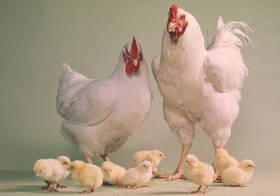Many species of birds
migrate long distances every year. Not only do they migrate over tens of thousands of miles, they almost always fly an exact route. The route is often independent of the landmarks they might fly over; for example, birds have been found to fly along some ancient riverbed, as if faithfully executing a pattern transferred from generation to generation:).

Chicken Family :D (Courtesy: PhysOrg)It has been known for some time that many species of birds use the Earth's magnetic field to select a direction of movement. However, although such birds clearly have a sense of direction, until now it has not been possible to train birds to move in a certain direction in the laboratory, even if they are motivated by a food reward. The reasons for this failure have been perplexing, but researchers now
report that they have been able to successfully accomplish this training task, providing new insight into the evolution of magnetic sensing and opening new opportunities for further study of magnetoreception:):).
In the new work, researchers including Rafael Freire from the
University of New England, Australia, Wolfgang Wiltschko and Roswitha Wiltschko from the
University of Frankfurt, Germany, and Ursula Munro from the
University of Technology in Sydney, demonstrated for the first time that birds could be trained to respond to a magnetic direction. The researchers trained domestic chicks to find an object that was associated with imprinting and was behind one of four screens placed in the corners of a square apparatus, and, crucially, showed that the chicks' direction of movement during searching for the hidden imprinting stimulus was influenced by shifting the magnetic field.
It is expected that this work will facilitate current efforts to understand how birds detect the magnetic field, because the new approach does not rely on complex behaviors, such as migration or homing, that are difficult to study in the laboratory and are dependent on the time of year. The work also shows that the ability to orient with magnetic cues is not only present in an ancient avian lineage dating back to the
Cretaceous period, but has also been retained in a nonmigrating bird after thousands of years of domestication:):):).